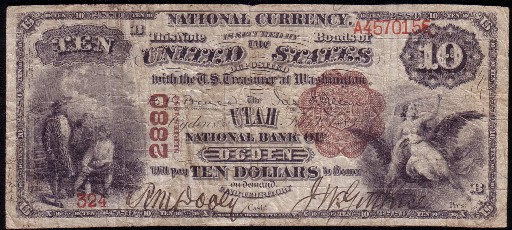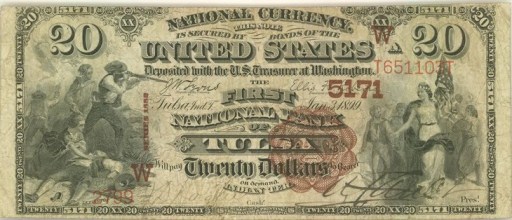The First National Bank Of Lisbon
The First National Bank Of Lisbon in North Dakota printed $501,300 dollars worth of national currency. That is a high amount, but condition and serial numbers can make otherwise common currency from this bank quite valuable. This national bank opened in 1887 and stopped printing money in 1928, which equals a 42 year printing period. That is a fairly normal lifespan for a national bank. During its life, The First National Bank Of Lisbon issued 9 different types and denominations of national currency. We have examples of the types listed below. Your bank note should look similar. Just the bank name will be different. For the record, The First National Bank Of Lisbon was located in Ransom County. It was assigned charter number 3669.
We buy all national currency. Please call or email us for a quote. Sales@AntiqueMoney.com
The First National Bank Of Lisbon in North Dakota issued 360 sheets of $10 1882 territorial brown back national bank notes. Collectors love to buy notes from such a small print run. It doesn’t get much smaller than under 500 sheets printed. The ten dollar 1882 territorial brown back was printed by more than 200 national banks, and more than 200 pieces are known to exist today. That number tends to go up by a handful each year as more are discovered. Often times the $10 territorial was the first and lowest denomination a bank received. About a dozen #1 specimens are held by collectors today, and there are probably many more still held by descendants of early pioneer bankers. Territorial bank notes are the cream of the crop when it comes to national bank notes. Most are at least rare and some can be very valuable. As always, the exact value is still based on bank of issue and condition. Something ugly from Oklahoma might only be worth $3,000, but other examples could be worth well over $10,000.
Series of 1882 $10 Territorial Brown Back
The First National Bank Of Lisbon printed 360 sheets of $20 1882 territorial brown back national bank notes. That number also represents the total number of twenty dollar bills printed for the type. Whether you have a ten or a twenty dollar territorial brown back, you should work with an expert to establish the value. Twenty dollar notes from this series were only printed at the rate of one to three compared to tens, but sadly, $20 1882 brown backs really don’t command a premium for their extra rarity. Only around fifty are known to exist today.
Series of 1882 $20 Territorial Brown Back
The First National Bank Of Lisbon also printed 2,279 sheets of $10 1882 brown back national bank notes. That sheet output number is small. Don’t expect too many of these to be available to collectors. There were three $10 bills printed on a single sheet of 1882 brown backs. The design of the bill is similar to all earlier ten dollar national bank notes. The nickname comes from the fact that these bills have a brown seal and brown overprint. Despite saying series of 1882, these were actually printed by some banks up until 1908. The date you see in cursive relates to when the bank first started issuing brown back notes.
Series of 1882 $10 Brown Back
The First National Bank Of Lisbon also printed 2,279 sheets of $20 1882 brown back national bank notes. As you can see, the sheet output is the same for $20 brown backs as it is for $10 brown backs. There was only one $20 brown back printed on a sheet. So the sheet output also equals the total note output. One neat thing about all brown backs is that they each have a different back design based on which state issued them. The back left hand side of the note shows the state seal of which ever state the national bank was located in. Generally speaking, 1882 $20 brown backs are pretty difficult to locate. They typically were printed in small numbers and they don’t have a great survival rate.
Series of 1882 $20 Brown Back
The First National Bank Of Lisbon also printed 160 sheets of $50 1902 blue seal national bank notes. There is no trick to knowing which 1902 blue seals will be common and rare. Often times the number printed won’t tell you much information. The value still comes down to condition and demand. That is a surprise to most people. In fact, most 1902 $50 bills we see are worth between $750 and $1,250. The rarer ones can be worth more than $5,000. However, there isn’t much middle ground.
1902 $50 Blue Seal National Bank Note
The First National Bank Of Lisbon also printed 160 sheets of $100 1902 blue seal national bank notes. It is no coincidence that the sheet numbers for $50 bills and $100 bills are the same. They were printed on the same sheets. Most $100 blue seals are at least scarce; others can be very rare. John J Knox is printed on the front of each bill. Most collectors like the back design a lot more though. It is really unique and different from most other national bank notes. Prices for 1902 $100 blue seals are pretty similar to $50 blue seals. They are both equally common or equally rare, depending on how you look at it.
1902 $100 Blue Seal National Bank Note
The First National Bank Of Lisbon also printed 6,330 sheets of $5 1902 blue seal national bank notes. That is a fairly standard sheet output for a national bank issuing blue seals. You likely aren’t dealing with a super common or a super rare bank note. Ben Harrison is on the front of all 1902 $5 blue seal bank notes. This happens to be the smallest denomination issued for the 1902 series. Each note is complete with a blue seal and blue charter number. Despite saying series of 1902, these were actually issued by national banks between 1908 and 1928. There are two different types of blue seals. The first type is called a date back and it has “1902-1908” written on the back of the bill. The other type is called a plain back; it does not have the date stamps on the back of the bill. The values for these notes range widely based on condition and the bank of issue.
1902 $5 Blue Seal National Bank Note
The First National Bank Of Lisbon also printed 647 sheets of $50 1902 blue seal national bank notes. There is no trick to knowing which 1902 blue seals will be common and rare. Often times the number printed won’t tell you much information. The value still comes down to condition and demand. That is a surprise to most people. In fact, most 1902 $50 bills we see are worth between $750 and $1,250. The rarer ones can be worth more than $5,000. However, there isn’t much middle ground.
1902 $50 Blue Seal National Bank Note
The First National Bank Of Lisbon also printed 647 sheets of $100 1902 blue seal national bank notes. It is no coincidence that the sheet numbers for $50 bills and $100 bills are the same. They were printed on the same sheets. Most $100 blue seals are at least scarce; others can be very rare. John J Knox is printed on the front of each bill. Most collectors like the back design a lot more though. It is really unique and different from most other national bank notes. Prices for 1902 $100 blue seals are pretty similar to $50 blue seals. They are both equally common or equally rare, depending on how you look at it.
1902 $100 Blue Seal National Bank Note



